Sanxenxo to Vigo
03/06/07 18:42 Filed in: Ria de Vigo
My original plan had been to leave early for Vigo, stopping en route at the Islas Cies for a few hours.
Events intervened. I got up late and there was no wind early on. The wind that did develop was not the best in which to lie at anchor off the islands. Another day....
Ian on "Sandaig" left about an hour before me bound for Puerta Pedras Negras on his way back to England.
Ian and "Sandaig"
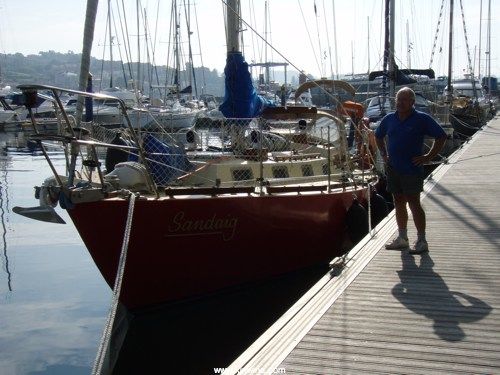
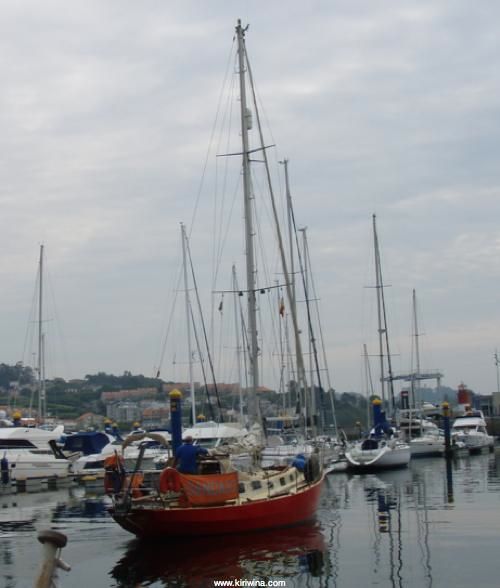
We finally got underway at 12:25 and cleared Sanxenxo marina at 12:35. Initially there was very little wind and we motorsailed for about 40 minutes until the wind veered to the northwest at around 10 knots. There followed a fabulous sail down the coast to the Ria Vigo. The wind steadily increased to 22 knots (F5) and we were flying along at well over 5 knots for much of the trip.
Once we entered the Ria de Vigo and passed Cabo Home the wind started to fade and we motored the last three miles to Vigo. As we approched the marina the wind picked up again which was unhelpful given the difficulty manoevring once inside.
The procedure is to moor at the fuel berth at the marina entrance and await berth allocation. The wind was blowing straight off this berth but I got alongside OK. Then I was allocated berth 119 which lay parallel to the fuel berth. The moorings here are med type where one moors stern to and picks up a bow line tailed to the pontoon. In still conditions this is fairly straight forward. With 12 knots of wind on the beam it gets interesting.
I got the stern close enough to get a line ashore but the bow swung around very quickly. Fortunately the marinero was able to use his dinghy as a tug and push us into a position where I could cleat off the bow line. The end result is that the boat sits stern to the pontoon and is held in equilibrium about 2 metres off by the bow line which is secured to the marina floor and spending most of its life underwater is covered in slime.
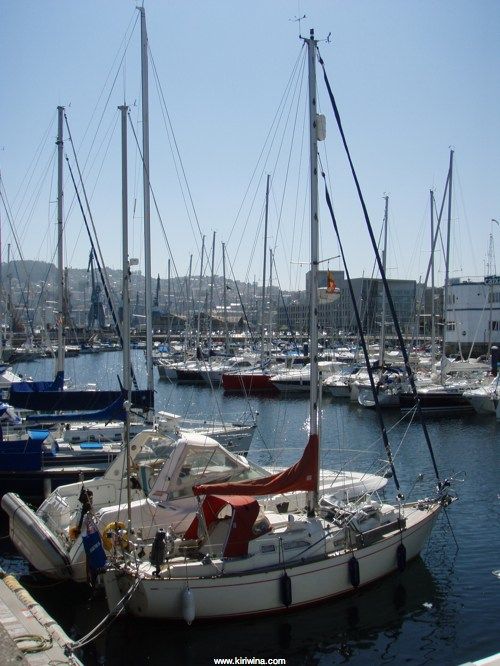
Once moored and during mooring plenty of fenders are required as adjacent boats often bounce off one another as they move about on the moorings.
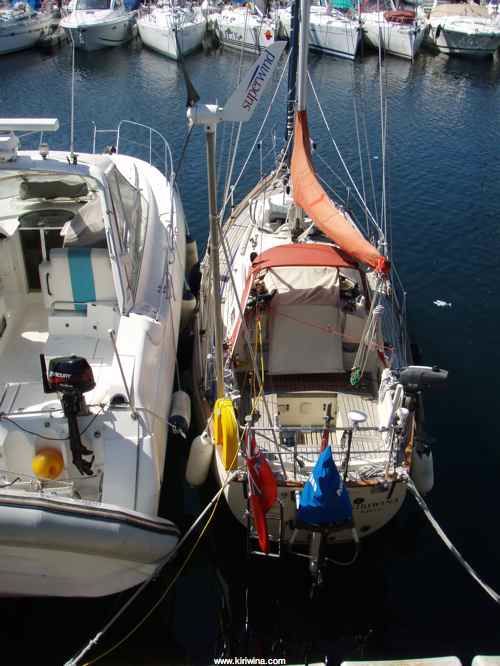
The merits of this arrangement are not apparent. I can only assume that the build cost is cheaper and more boats can be got into the available space. For the single hander it is a very dodgy proposition but we were all fast at on berth 119, Real Club Nautico de Vigo at 17:35.
Getting ashore is interesting. Kiriwina has a stern hung rudder and Dame Kiri, our Aries, projects beyond the rudder. One must first pull on a stern line to bring the stern within jumping distance, climb over the pushpit onto Dame Kiri taking care not to interfere with any of the four aerials on the top rail, and leap ashore. If this is not done smartly the boat will resume its position 2 metres off the pontoon and the process must be repeated.
Later in the evening I went for a coffee in one of the numerous waterfront cafes near the Club Nautico. This part of the waterfont is quite attractive.
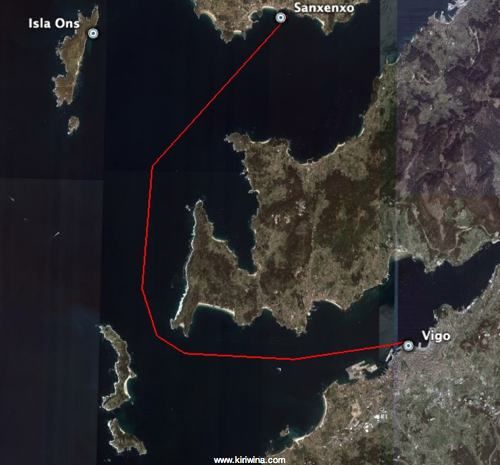
Events intervened. I got up late and there was no wind early on. The wind that did develop was not the best in which to lie at anchor off the islands. Another day....
Ian on "Sandaig" left about an hour before me bound for Puerta Pedras Negras on his way back to England.
Ian and "Sandaig"


We finally got underway at 12:25 and cleared Sanxenxo marina at 12:35. Initially there was very little wind and we motorsailed for about 40 minutes until the wind veered to the northwest at around 10 knots. There followed a fabulous sail down the coast to the Ria Vigo. The wind steadily increased to 22 knots (F5) and we were flying along at well over 5 knots for much of the trip.
Once we entered the Ria de Vigo and passed Cabo Home the wind started to fade and we motored the last three miles to Vigo. As we approched the marina the wind picked up again which was unhelpful given the difficulty manoevring once inside.
The procedure is to moor at the fuel berth at the marina entrance and await berth allocation. The wind was blowing straight off this berth but I got alongside OK. Then I was allocated berth 119 which lay parallel to the fuel berth. The moorings here are med type where one moors stern to and picks up a bow line tailed to the pontoon. In still conditions this is fairly straight forward. With 12 knots of wind on the beam it gets interesting.
I got the stern close enough to get a line ashore but the bow swung around very quickly. Fortunately the marinero was able to use his dinghy as a tug and push us into a position where I could cleat off the bow line. The end result is that the boat sits stern to the pontoon and is held in equilibrium about 2 metres off by the bow line which is secured to the marina floor and spending most of its life underwater is covered in slime.

Once moored and during mooring plenty of fenders are required as adjacent boats often bounce off one another as they move about on the moorings.

The merits of this arrangement are not apparent. I can only assume that the build cost is cheaper and more boats can be got into the available space. For the single hander it is a very dodgy proposition but we were all fast at on berth 119, Real Club Nautico de Vigo at 17:35.
Getting ashore is interesting. Kiriwina has a stern hung rudder and Dame Kiri, our Aries, projects beyond the rudder. One must first pull on a stern line to bring the stern within jumping distance, climb over the pushpit onto Dame Kiri taking care not to interfere with any of the four aerials on the top rail, and leap ashore. If this is not done smartly the boat will resume its position 2 metres off the pontoon and the process must be repeated.
Later in the evening I went for a coffee in one of the numerous waterfront cafes near the Club Nautico. This part of the waterfont is quite attractive.

